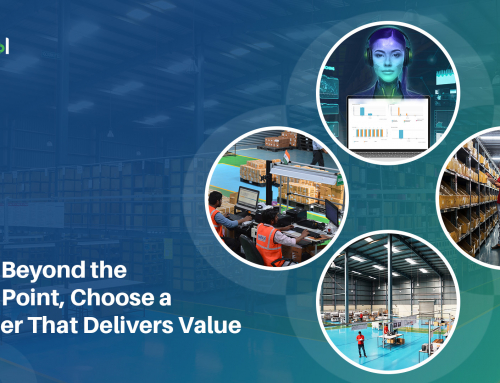Warehousing Vs Fulfilment
Fulfilment is about product ‘availability’ and warehousing is about ‘storage and distribution’
Fulfilment and warehousing, though often considered substitutable in the world of logistics, are actually, very different in nature and the objectives that they are expected to achieve. While no one can deny that these fundamental cogs in the wheel of the Supply Chain super structure have a whole lot in common, understanding their differences is critical in order to make informed decisions especially when it comes to choosing relevant 3PL services.
Let’s look at some of the core differences between Warehousing and Fulfilment to help you gain a deeper understanding of these processes and to prevent mixing them up as identical.
Purpose: Storage Vs Pick, Pack & Ship
The primary function of warehousing, as the name suggests, is all about storing goods in bulk on behalf of manufacturers / companies / business entities. Warehousing usually requires enormous floor or shelf space to accommodate boxed/palletised products that are sorted and stored in terms of their distinctive categories.
Fulfilment, on the other hand, is an entire ecosystem of functions that cater to shipping and delivering orders from Business to Business (B2B) or Business to Customers (B2C). Fulfilment process begins to roll on reception of orders until which, the products are stored in warehouses.
Handling: Box In Box Out Vs Box In Piece Out
Warehouses are all about incoming and outgoing boxes/pallets. Here the inventory movement happens in conglomeration and mostly channeled towards fulfilment. Warehouse inventory movement is never in the form of single-unit or, piece-wise doorstep delivery to end customers.
Fulfilment on the other hand, witnesses unit-wise movement of inventory where, individual pieces from boxes that have arrived from warehouses / storage facilities are Picked, Packed, Labelled and Shipped to respective addresses from where the order was placed.
Next usage point: Consumer Vs B2B point
The orders processed from the warehouse are typically for next use point which is another B2B node in supply chain – another warehouse, FC, dealer, distributor, retail store etc. Whereas in fulfilment, the end point is the consumer directly. This puts a lot of pressure on how goods are fulfilment by maintaining highest quality in all the processes in fulfilment centre as the chances of rectifying mistakes become very costly and can result in losing a customer for lifetime. In warehousing, there is an opportunity to rectify mistakes at the next B2B point before it reaches the end consumer.
Order Volume And Storage Time Frame
Even though both warehouses and fulfilment centers are equipped to stock inventory, consignments stored in warehouses are anytime, more voluminous than fulfilment centers. Since the core purpose of warehouses is to ‘store’, they are designed with enormous floor & shelf spaces to stock goods in perfect condition for a longer period.
Fulfilment centers though, store unit wise goods that are taken out from boxes or pallets and stored on shelves. So, they remain in the fulfilment shelves only till the time they are packed and shipped. Therefore, their volume and time frame for storage is way lower than warehouses.
Inventory Movement Speed / Frequency –
Frequency of inventory movement in warehouses is slower in comparison with fulfilment centers, and the reason is obvious – warehouses ‘stores’ while fulfilment works around ‘completing orders’.
Did you know… inventory that does not move out of a fulfilment center in 4 weeks is considered a liability.
Inventory in warehouses, quite contrarily, can be stored for months together and even a year or more when required.
Simple Process Vs Complex Operational Process –
Roughly, there are 6 primary warehousing processes that includes:
- Receiving consignments in docks
- Putting them in their respective locations in the warehouse
- Keeping count of boxes received
- Shipping / moving inventory to respective fulfilment locations
- Receiving and restocking units following reverse logistics
Even though these processes are critical and need to be handled with absolute responsibility, they are relatively simpler in comparison with fulfilment.
Fulfilment involves high speed, high frequency processes that starts to roll after confirmation of orders and includes:
- Order processing
- Picking, where items are collected according to essential information on the picking-slip
- Packing and labeling, for safe, space effective and cost-effective deliveries
- Shipping with trusted courier/other freight services
- Delivery where the parcel is delivered to the end customer’s doorstep
Did you know… Picking is one of the costliest processes in fulfilment consuming up to about 55% of the operating costs of a fulfilment center.
Low Value-Added Services Vs High Value-Added Services –
Warehousing or Fulfilment, Value Added Services (VAS) are offered in both. However, owing to process simplicity, VAS in warehousing is rather restricted in contrast with VAS offered in fulfilment.
Some of the core value added services in warehousing includes kitting, bundling and real time visibility.
VAS in fulfilment is more extensive and includes – paperless pick and pack; tagging and labeling; quality check and control; cycle count; refurbishment and more.
Low Manpower Intensity Vs High Manpower Intensity –
Another important difference between warehousing and fulfilment is the level of manpower involved in these processes. Warehousing usually requires less manpower given that the core processes like receiving consignments, putting them away and sorting are handled by machines. Automated record of inflow and outflow of inventory further reduces manpower requirements.
Fulfilment though, is a high-speed process with a long list of sub processes that require careful supervision and trained meticulous handling for error free completion. Therefore, manpower requirement here is considerably higher. This is also one of the reasons why requirement for sectoral expertise in fulfilment is higher in comparison with warehousing.
Real Time Visibility: Important Vs Imperative –
Real time transparency strengthens the supply chain eco system. Tracing and tracking inventory movement by the minute is the call of the day in logistics.
However, given that inventory in warehouses is usually static, the need to track them in real time is seldom as critical as it is in fulfilment centers where inventory units constantly move through innumerable essential processes till they reaches the doorstep of customers in their respective destinations.
Therefore, it is always ‘good’ to have real time transparency in warehousing. But it is an ‘absolute necessity’ in fulfilment.
Repackaging Not Required Vs Repackaging Absolutely Necessary –
Repackaging is a value-added service that takes place when a certain product requires changes or reconfigurations. Clients expecting their products to be repacked in third party fulfilment company’s own branded packaging rather then the original manufacturer’s packaging, is a common example of repackaging. Adjusting parcel content to meet changing customer requirements is also an example of the same.
Given the sensitive nature of the repackaging process, meticulous and absolutely faultless monitoring, tracking and labeling is called for and this is best done in fulfilment centers. These days, repackaging has become a criterion for customers to determine credibility of 3PL fulfilment services.
Even though there are some warehouses that offer repackaging at certain levels, they are usually not equipped for end-to-end repackaging given that their primary processes are more static and restricted.
On Time & In Full (OTIF) –
On time and in full (OTIF) is a critical performance metric that helps businesses track, understand, meet and exceed end customer purchase experience and expectations. By the simplest definition, OTIF measures whether the parcels are delivered to their respective addresses on time and whether they are delivered in the quantity as specified by the latter.
While OTIF is important in all stages of supply chain, including warehousing, it is critical and non-negotiable in fulfilment. In fact, it is the key performance metric that directly contributes to maximized business profitability.
Final Thoughts
Warehousing and Fulfilment are defined by unique objectives, characteristics and processes that come together to complete the supply chain circle. It is important for any business to understand these points with the view on their long-term plans to opt for the right kind of service provider. Earlier, these differences were not understood well and lot of businesses ended up working with warehousing service providers for their fulfilment needs, getting sub-optimal performance and making their brand suffer. These differences have become even more pronounced as the market dynamics become more centred around improving customer experience and faster fulfilment.









